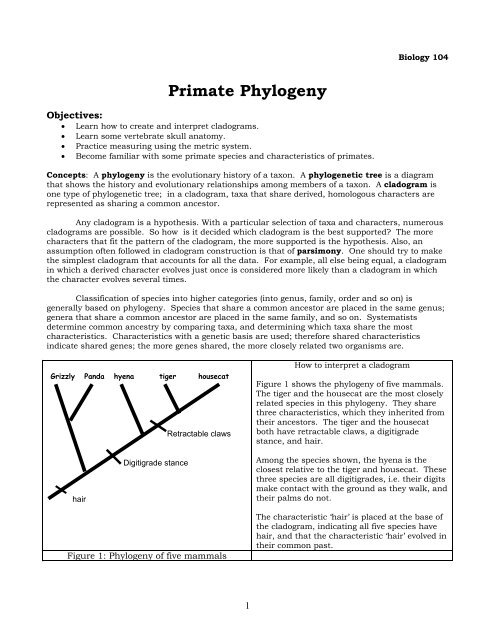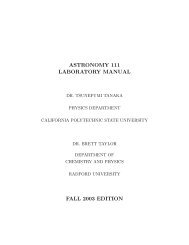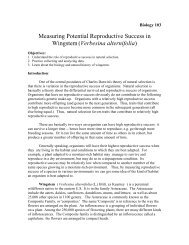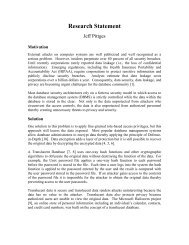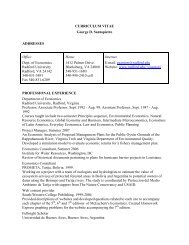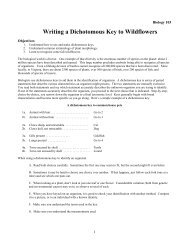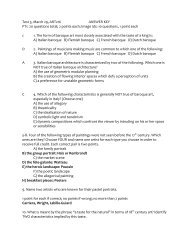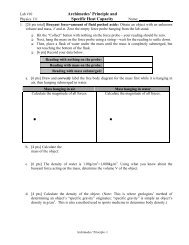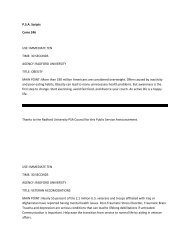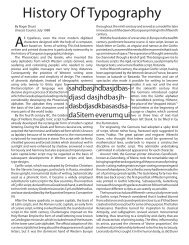Primate Phylogeny
Primate Phylogeny
Primate Phylogeny
Create successful ePaper yourself
Turn your PDF publications into a flip-book with our unique Google optimized e-Paper software.
Biology 104<br />
<strong>Primate</strong> <strong>Phylogeny</strong><br />
Objectives:<br />
• Learn how to create and interpret cladograms.<br />
• Learn some vertebrate skull anatomy.<br />
• Practice measuring using the metric system.<br />
• Become familiar with some primate species and characteristics of primates.<br />
Concepts: A phylogeny is the evolutionary history of a taxon. A phylogenetic tree is a diagram<br />
that shows the history and evolutionary relationships among members of a taxon. A cladogram is<br />
one type of phylogenetic tree; in a cladogram, taxa that share derived, homologous characters are<br />
represented as sharing a common ancestor.<br />
Any cladogram is a hypothesis. With a particular selection of taxa and characters, numerous<br />
cladograms are possible. So how is it decided which cladogram is the best supported? The more<br />
characters that fit the pattern of the cladogram, the more supported is the hypothesis. Also, an<br />
assumption often followed in cladogram construction is that of parsimony. One should try to make<br />
the simplest cladogram that accounts for all the data. For example, all else being equal, a cladogram<br />
in which a derived character evolves just once is considered more likely than a cladogram in which<br />
the character evolves several times.<br />
Classification of species into higher categories (into genus, family, order and so on) is<br />
generally based on phylogeny. Species that share a common ancestor are placed in the same genus;<br />
genera that share a common ancestor are placed in the same family, and so on. Systematists<br />
determine common ancestry by comparing taxa, and determining which taxa share the most<br />
characteristics. Characteristics with a genetic basis are used; therefore shared characteristics<br />
indicate shared genes; the more genes shared, the more closely related two organisms are.<br />
Grizzly Panda hyena tiger housecat<br />
Retractable claws<br />
How to interpret a cladogram<br />
Figure 1 shows the phylogeny of five mammals.<br />
The tiger and the housecat are the most closely<br />
related species in this phylogeny. They share<br />
three characteristics, which they inherited from<br />
their ancestors. The tiger and the housecat<br />
both have retractable claws, a digitigrade<br />
stance, and hair.<br />
hair<br />
Digitigrade stance<br />
Among the species shown, the hyena is the<br />
closest relative to the tiger and housecat. These<br />
three species are all digitigrades, i.e. their digits<br />
make contact with the ground as they walk, and<br />
their palms do not.<br />
Figure 1: <strong>Phylogeny</strong> of five mammals<br />
The characteristic ‘hair’ is placed at the base of<br />
the cladogram, indicating all five species have<br />
hair, and that the characteristic ‘hair’ evolved in<br />
their common past.<br />
1
Practice Problem: Construct a cladogram showing the evolutionary relationships among the taxa<br />
listed in Table 1. First, decide which taxa have which characters and put the results in Table 1.<br />
TAXA<br />
dog kangaroo lizard Trout<br />
CHARACTERS<br />
Hair<br />
Placenta<br />
bony limbs<br />
Vertebra<br />
Table 1: Characters of selected vertebrate taxa<br />
In making a cladogram from the available data, one of the first things to do is to choose the<br />
outgroup. The outgroup is a taxon that is related to the other taxa, but is not a member of the<br />
group formed by the other taxa. Here, trout is the outgroup. It's related to the other three taxa (all 4<br />
are vertebrates) but the other three are all more closely related to each other than to the trout.<br />
(Trout lacks lungs and bony limbs, which the other three all have.)<br />
To determine whether a character is ancestral or derived compare the character in the<br />
ingroup with that of the outgroup. Assume that the character in the outgroup is ancestral. If the<br />
character is different in the ingroup, then it is considered derived --[ i.e., as evolution took place, the<br />
character has changed from its ancestral state to its derived state.[ Use ‘A’ to symbolize the<br />
ancestral character and a ‘D’ to symbolize a derived character. (Campbell et al. use the term<br />
'primitive' rather than 'ancestral.') However, 'primitive' tends to have a negative connotation and<br />
'ancestral,' meaning 'similar to that of the ancestors' is descriptive, but neutral.)<br />
Fill in the Table 2 to reflect whether the characters are ancestral (A) or derived (D).<br />
Table 2: Polarity of characters of selected vertebrate taxa<br />
TAXA<br />
Dog kangaroo lizard Trout<br />
CHARACTERS<br />
Hair<br />
Placenta<br />
bony limbs<br />
vertebra<br />
Draw a cladogram below that conforms with the data in the Table 2. Label the cladogram with the<br />
shared, derived characters in the appropriate places.<br />
2
Introduction: There are about 50,000 species of vertebrates, all of which share common<br />
ancestry; two homologies common to all vertebrates are the dorsal hollow nerve cord, and vertebrae.<br />
Your assignment today will be to determine the evolutionary relationships of six vertebrates, based<br />
on a set of characters listed below.<br />
Skulls from six vertebrates are in the classroom. One species from the Order Rodentia is<br />
available, as well as five species from the Order <strong>Primate</strong>s.<br />
Methods: Collect data from the skulls of the six species available. Observe and take<br />
measurements on each skull and record the data in Table 3.<br />
Make all measurements in millimeters. Terms are pictured or defined below, as ae<br />
instructions on how to take the measurements. Figure 2 illustrate the bones of the human skull.<br />
The same names are used for the homologous bones on the other vertebrates.<br />
Do not point to parts of the skulls with the writing end of pens, pencils, or markers.<br />
Occipital bone<br />
Figure 2: Side view of human skull.<br />
This diagram is from the online edition of the 20 th U.S. edition of<br />
Gray's Anatomy of the Human Body, originally published in 1918.<br />
3
Instructions on Measuring – measurements of homologous features must be taken in the same<br />
way on each skull, so that they are comparable and repeatable.<br />
Eye socket (orbit) – a complete eye socket has a circular ring of bone around the orbit (the location<br />
of the eyeball). In an incomplete eye socket, the bone around the orbit does not form a circular ring.<br />
Sagittal crest – a crest at the sagittal suture. The sagittal suture is the joint between the left and<br />
right parietal bones. There may be a bony crest at this suture, to which jaw muscles are attached.<br />
Lamboidal crest – a crest at the lamboidal suture. The lamboidal suture is the joint between the<br />
parietal bones and the occipital bone; thus, it is found in the posterior half of the skull. In some<br />
organisms there may be a bony crest or keel present at this suture, to which muscles are attached.<br />
Foramen magnum – relative position – the foramen magnum is the name of the large hole in the<br />
base of the skull where the spinal cord enters the skull; the cord then connects to the base of the<br />
brain. Establish a relative position of the foramen magnum on the skull.<br />
1. Is the foramen magnum about midway between the incisors and the lamboidal suture ?<br />
2. Is the foramen magnum closer to the incisors than to the lamboidal suture, i.e. is it closer to the<br />
front of the skull than it is to the back ?<br />
3. Is the foramen magnum closer to the lamboidal suture than it is to the incisors, i.e. is it closer to<br />
the back of the skull than it is to the front ?<br />
Length of maxilla – the maxilla is the upper part of the jaw, and this measure will correspond to the<br />
length of the snout. Measure from the posterior edge of the hard palate (the bony roof of the mouth)<br />
to the anterior edge of the incisors. You may carefully remove the mandible on all the skulls, except<br />
for human, to facilitate this measure.<br />
Bizygomatic arch breadth – the zygomatic arch is the bone bridge just below the orbit. Measure the<br />
breadth of the face from the most lateral edge of one zygomatic arch to the most lateral edge of the<br />
other zygomatic arch.<br />
Relative snout length – length of maxilla divided by the bizygomatic arch breadth. Do the division.<br />
Not all of the organisms have the same body size, so calculating this ratio will take the differeing<br />
body sizes into account.<br />
Dental formula -- The dental formula is a series of numbers that reflect the arrangement of the<br />
various kinds of teeth on the upper and lower jaws of mammals. (See Figure 3 on next page.)<br />
For example, the dental formula of the house cat (Felis catus) is 3/1/3/1 – 3/1/2/1. The<br />
skeleton of a house cat is available for observation. The first four numerals reflect the arrangement<br />
of teeth on one side of the upper jaw. Starting at the anterior median line on the upper jaw and<br />
proceeding posteriorly, there are 3 incisors, 1 canine, 3 pre-molars and 1 molar. The second four<br />
numerals reflect the arrangement of teeth in the lower jaw. Starting at the anterior median line and<br />
proceeding posteriorly, there are 3 incisors, 1 canine, 2 premolars, and 1 molar. Look at the cat<br />
skull to familiarize yourself with the different kinds of teeth. Note that the incisors are in front, and<br />
are flat in cross section. Next are the canines, which tend to be conical and pointed. The cheek<br />
teeth, the premolars and molars, are for grinding food. The premolars are sharper and substantially<br />
smaller than the molars.<br />
Canine diastema – on the maxilla, a space between the incisors and the canine, that leaves room for<br />
the opposing canine to fit when the jaw is closed.<br />
Cranial volume -- A crude measure of the volume of each cranium can be measured using beans<br />
and beakers. Through the foramen magnum, fill the cranium completely with the beans. While<br />
filling, occasionally shake gently so the beans will settle and completely fill the cranium. Once the<br />
4
cranium is full of beans, decant the beans from the cranium and measure their volume in milliliters<br />
using a beaker or graduated cylinder.<br />
Terms used to describe anatomical position: A number of terms are used quite frequently in<br />
describing the position of anatomical structures.<br />
Some of these terms (anterior, dorsal, lateral, medial, posterior) are often used relatively. For<br />
example, if we say that the diaphragm is anterior to the stomach, it does not mean that you will find<br />
the diaphragm at the anterior end of the organism. It means that, once you find the stomach, you<br />
will find the diaphragm on the anterior side of the stomach, i.e. the side closest to the anterior end of<br />
the animal.<br />
anterior -- the head end of an animal, or in that direction. (e.g. on the pig, the front legs are<br />
anterior to the umbilical cord.)<br />
dorsal -- the back or upper side of an animal, or in that direction. (e.g. the vertebral column is<br />
dorsal to the heart.)<br />
lateral -- the side, or toward the side.<br />
medial or median -- on or toward the midline of the organism.<br />
posterior -- the tail end of an animal, or in that direction.<br />
molars<br />
premolars<br />
incisor<br />
canine<br />
Figure 3: Mandible of human showing arrangement of teeth<br />
This diagram is from the online edition of the 20 th U.S. edition of<br />
Gray's Anatomy of the Human Body, originally published in 1918.<br />
5
Table 3: Characteristics of selected vertebrates<br />
TAXA Orangutan<br />
Pongo<br />
Fox<br />
Vulpes<br />
Rhesus<br />
monkey<br />
Macaca<br />
Chimpanzee<br />
Pan<br />
CHARACTERS<br />
pygmaeus vulpes mulatta troglodytes<br />
Complete eye socket?<br />
Sagital crest<br />
present or not<br />
(note relative size)<br />
Lamboidal crest present or<br />
not<br />
(Note relative size)<br />
Brow ridge<br />
(note relative size)<br />
Distance from foramen<br />
magnum to front<br />
Distance from foramen<br />
magnum to lamboidal suture<br />
Relative position of the<br />
foramen magnum<br />
Length of maxilla<br />
Bizygomatic arch breadth<br />
Relative snout length<br />
Total number of teeth<br />
Dental formula<br />
Relative size of longest canine<br />
to longest incisor<br />
(Is canine length much longer<br />
or about the same size as the<br />
incisor?)<br />
Canine diastema present or<br />
not<br />
Molars and premolars<br />
arrangement parallel or<br />
arched ?<br />
Circumference of skull at mid<br />
orbit<br />
Cranial capacity,<br />
Milliliters<br />
Ratio of cranial capacity to<br />
circumference of skull<br />
Gorilla<br />
Gorilla<br />
gorilla<br />
Human<br />
Homo<br />
sapiens<br />
Number of caudal<br />
vertebrae(vertebrae in tail)<br />
3 25 15 2 2 3<br />
Biped or quadruped<br />
6
Results: You have quite a bit of information in Table 3. This may be more information than you<br />
need to determine the phylogeny of these six species. Also, some of the data may not be helpful in<br />
determining phylogeny. Just as other scientists must do, you will have to choose which characters<br />
are useful in determining phylogeny, and which are not.<br />
First, decide which characters are most useful for discriminating evolutionary relationships.<br />
You might consider how difficult it would be from a genetic and/or developmental standpoint for a<br />
particular character to change/mutate from one state to another. For example, you could easily<br />
imagine a species evolving a somewhat longer canine, but it is probably a much more complicated<br />
(and hence less likely) step to go from lacking canines to having canines (or vice versa). List the<br />
characters you think are most useful.<br />
Second, choose your outgroup and polarize (i.e. determine whether ancestral or derived) the<br />
characters you've chosen as useful.<br />
Third, draw a cladogram that you think is best supported by the data that you have collected<br />
and chosen. Remember, the greater the number of shared, derived, homologous characters, the more<br />
closely related are the two taxa. Include the derived characters in the appropriate places on the<br />
cladogram.<br />
Discussion and Conclusions:<br />
1. For your cladogram, write a paragraph that explains why and how you decided that this was<br />
a plausible cladogram. (e.g., address why you chose the characters and outgroup you did.)<br />
2. The cladogram you have made is a hypothesis. What are some ways you could further test<br />
this hypothesis ?<br />
3. What are some of the characteristics found in all the <strong>Primate</strong> skulls ?<br />
4. What are some of the differences between the skull of Homo sapiens and the other primates.<br />
5. What character(s) do you see in the human skull that is/are unique to humans?<br />
6. Some species are known only from fossils. Is it possible to know anything about the behavior of<br />
such species? For instance, how can one determine from fossil evidence alone, whether a species is<br />
a biped or a quadruped? That is, which of the skeletal characters you have recorded from these<br />
species is most associated with bipedalism?<br />
Literature cited:<br />
Gray, Henry. 1918. Gray’s anatomy of the Human Body, 20 th edition. [Online].<br />
Available: http://education.yahoo.com/reference/gray/ [ Jan 10, 2006].<br />
For further information:<br />
Theobald, Douglas. 1999-2004. Phylogenetics Primer at Talk.Origins. [Online]. Available<br />
http://www.talkorigins.org/faqs/comdesc/phylo.html [Jan. 10, 2006]<br />
Tree of Life Web Project. 1995-2004. Tree of Life. [Online]. Available:<br />
http://tolweb.org/tree/phylogeny.html [Jan. 10, 2006].<br />
Waggoner, Ben. Living <strong>Primate</strong>s, or This Means You. [Online]. Available:<br />
http://faculty.uca.edu/~benw/biol4402/lecture14/sld001.htm [Jan. 10, 2006]<br />
7


